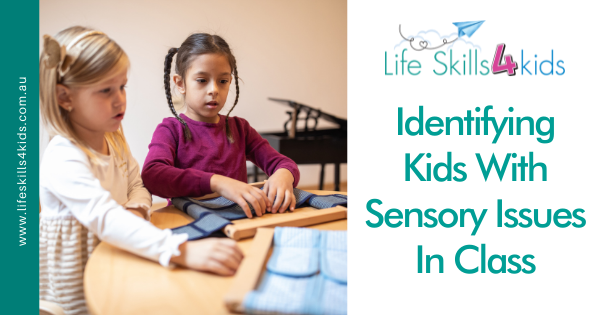Many students are struggling with behaviour and ‘sensory-driven’ behaviour in class. It might look like difficulties with concentration and poor attention, or it might look like a child rushing through his work. It might look like a child who always needs to have her desk perfectly tidy and aligned. It might look like the child who is the class clown who falls out of his seat, or the child who is loud, angry and ready for a fight or at least a disagreement.
Kids with sensory issues in class do not look the same. Not all of them are having behaviour issues, or in meltdown every day.
As I visit preschools and classrooms around my school district, I often walk into the room and find a child I’m seeing professionally trying their best to participate, which often doesn’t look like this, and he or she is not the only one struggling. I can usually find 4 or 5 children in the class whom I’d love to be helping as well. They are trying their best to do what is asked and expected, but they are struggling because of their sensory systems. Kids with sensory issues try their best, but find that their nervous systems are easily overloaded; or the opposite, that they need lots of sensory input to ‘wake up’ or be alert enough to engage and learn.
Often, it looks like they are the child who is on a behaviour plan. They may be on a warning card for the morning already, or they may be on reduced hours or at risk of suspension.
These are some of the outward and noticeable signs of a child with sensory processing difficulties. But they are not just being naughty, or being “behavioural” or oppositional.
Often children show behavioural issues due to sensory overload, or needing to gain extra sensory information to be alert and ready for learning.
Identification of sensory signals is one aspect of assisting kids with sensory issues in class that is often overlooked.
Here are the 5 top signs that might pinpoint a child who is struggling with sensory processing issues in class.
- The fidgeter: these kids can’t keep their fingers still or their hands to themselves. They play with the loose thread on their shirt, they fiddle with their friend’s jumper, they pick up fluff from the floor, they rub their hands on the carpet at group floor time, or at their desk they twirl their ruler or pencil. This may be visually or audibly distracting (by the noise of it tapping on the desk), but for them, they are feeding their sensory systems making it easier for them to focus and concentrate.
- The wiggler and rocker: these kids are always on the move. Even in their seats they are rocking and rolling, front to back and side to side. They love having their head upside down, so brushing pencils and rulers off their desk and bending over to pick them up helps them feel good and more alert. These kids are often out of their chair and walking around the room. A teacher’s nightmare, they have a never-ending supply of energy too. But they are feeding their movement or vestibular sensory system, and this helps them to be in the just right zone for concentrating.
- Visual signs: the child with visual sensory difficulties may find it hard to copy from the board, or may struggle with sitting side on to the board and having to turn around to look and copy. These kids may squint in class, and may be easily distracted, or may even find it hurts their eyes if there is too much glare on the smart board or coming through the windows. Flickering fluorescent lights often bother these kids and can either be distracting or may even impact their emotions and increase their frustration.
- Auditory anxiousness: noise in classrooms can be distracting, or even anxiety-producing for some children. The chatter of children, the noise of the bell, and even trying to understand and focus on what a teacher is saying from across the room can all impact learning and engagement in class.
- Postural strength: often the kids we see with sensory issues also have low muscle tone and poor core stability, so sitting on the floor or at a desk for a prolonged period is very tiring. To counteract this, they change sitting positions regularly, which can look like movement-seeking, wiggling in their seat and leaning or lounging on the floor, or even all over their neighbour.
Understanding the sensory aspects impacting in a classroom setting can allow potential environmental factors to be addressed and improved.
Many teachers I work with are struggling A LOT to manage their classrooms and manage children with myriad different sensory processing needs. Effective classroom management for children with sensory processing needs takes:
- An awareness and understanding of the underlying reasons kids might be struggling
- An awareness that many children in their class may have some sensory processing issues
- An awareness and understanding of the classroom environment and how the physical environment impacts directly on classroom behaviour and learning.
Having a clear understanding of these issues and knowing how to seek continued professional development skills to change your classroom can make a massive improvement, not just on kids with sensory issues in class, but for all children.
________________________________
Deb Hopper… Occupational Therapist, author, workshop presenter. Deb is passionate about empowering parents and educators to understand the underlying reasons of why children struggle with behaviour, self-esteem and sensory processing difficulties. A practicing Occupational Therapist, she understands the daily struggles that children, parents and teachers face.
Deb is the co-author of the CD Sensory Songs for Tots, and author of Reducing Meltdowns and Improving Concentration: The Just Right Kids Technique.
The Just Right Kids Technique Model can be downloaded at: https://www.lifeskills4kids.com.au/just-right-kids-model/
You can contact Deb on 02 6555 9877. She is available for clinic and phone/ Skype consultations.

